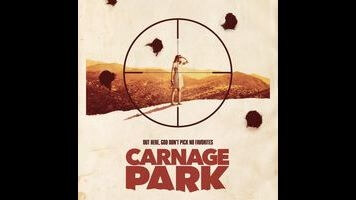There’s nothing original about Carnage Park, but it’s still a fun ride

If the ’90s grindhouse revival was all about updating the aesthetic of trashy ’70s B-movies, then the 2010s revival of the ’90s revival is just going to be more of the same. At least, that’s the case with Carnage Park, a grindhouse-horror throwback that wears its influences on its bloody, tattered sleeve. Even the name recalls Punishment Park, Peter Watkins’ 1971 faux documentary where prisoners are hunted for sport in the California desert. Humans are hunted for sport here, too, in what is obviously California but where people talk with Southern accents because it sounds cool.
But the dynamic between hunter and hunted is more conventional here than in Watkins’ film. Instead of a group of National Guardsmen with guns, we’ve got one deranged veteran—a favorite theme of director Mickey Keating—with a whole bunch of guns, and a tract of land that he’s retrofitted into his own personal murder theme park. He’s one of those godlike serial killers, crazy enough to kidnap and kill dozens of people and collect their body parts as totems, but sane enough to orchestrate elaborate obstacle courses for them in the process. Played by a practically unrecognizable Pat Healy in a buzz cut and dorky glasses, Wyatt Moss prefers to communicate with his victims via a primitive PA system as they wander around discovering the various grisly tableaux he’s laid out for them in “Carnage Park.”
That’s not where we start, though. We start with a scene straight out of Reservoir Dogs, as bank robber Scorpion Joe (James Landry Hébert) coaches his partner in crime Lenny (Michael Villar) as the latter bleeds to death from a bullet in the gut in the back of their car after a botched job that, in another nod to Reservoir Dogs, we don’t actually see on screen. Poor Lenny doesn’t make it, prompting Joe to pull over and drag their hostage, farm girl Vivian (The Last Exorcism’s Ashley Bell), out of the trunk to help him dispose of the body. This entire section of the movie is slavish in its homage to Tarantino—we don’t use the word “ripoff” where Tarantino’s concerned, the irony is just too much—with its stylized tough-guy patter, spaghetti Western fonts, and slow-motion sequences set to retro pop music. Keating simply says that he’s paying homage to the same ’70s genre movies (the copyright date of the film is set as 1978 in the credits) that Tarantino did early in his career. Still, the similarities are undeniable.
But no matter, as Scorpion Joe gets his brains splattered all over the window of his car abut a half hour in, freeing Vivian to run into Wyatt’s trap and for the movie to shift gears from bloody action to gruesome horror. The prevailing aesthetic of the film from this point on is all camouflage and rusted metal, with cinematographer Mac Fisken tinting everything a little bit yellow to match both the retro theme and blinding sunlight. The “creepy weirdo loner in the desert” theme recalls The Hills Have Eyes, but with a bit of a doomsday-prepper edge; as the story progresses, though, mummified bodies and little figures made of straw and bone start to enter the film’s visual vocabulary, leading to a climactic showdown in a mine shaft that looks like a set from The Texas Chain Saw Massacre. (Well, The Texas Chainsaw Massacre 2, if you want to get technical.) Meanwhile, the local sheriff, played by veteran character actor Alan Ruck, is determined to finally stop the mayhem that he’s been passively encouraging for years.
Movies like Carnage Park always raise the question: Does something have to be completely original to be any good? Anyone with an affection for the films cited above or a Larry Fessenden cameo—probably two very similar fan clubs—will find something to appreciate. (What genre fan wouldn’t be at least a little bit interested in “Quentin Tarantino’s Saw?”) Visually, it’s well done, as is Gino Ostinelli’s score (as opposed to the pop soundtrack, which can feel derivative). And Keating keeps the story tight, giving the audience enough twists and turns to keep the ride fun. Keating just made Darling, another stylized homage to horror’s past, and risks being labeled a mere imitator if he doesn’t find a way to synthesize his influences in a less literal way in future films. His enthusiasm is endearing, but it’s time to evolve.